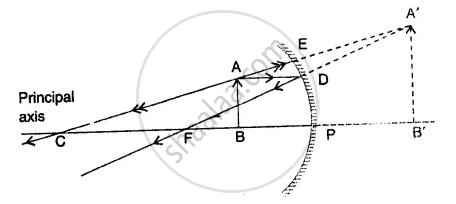Advertisements
Advertisements
Question
Draw a ray diagram to show the formation of image of an object placed between the pole and focus of a concave mirror. State the position, size and nature of the image.
Solution
OBJECT LIES BETWEEN FOCUS AND POLE :

A virtual erect and bigger image is formed behind the mirror
Image formed A’B’ is on the other side of the mirror on producing ← position
Enlarged (magnified) ← size
Virtual and erect ← nature
APPEARS IN
RELATED QUESTIONS
The image formed by a concave mirror is observed to be virtual, erect and larger than the object. Where should the position of the object be relative to the mirror? Draw ray diagram to justify your answer.
A student has obtained the image of a distant object with a concave mirror to determine its focal length. If he has selected a well-illuminated red building as object, which of the following correctly describes the features of the image formed?
(A) Virtual, inverted and diminished image in red shade
(B) Real, erect and diminished image in pink shade
(C) Real, inverted and diminished image in red shade
(D) Virtual, erect and enlarged image in red shade
A concave mirror produces three times magnified image on a screen. If the object is placed 20 cm in front of the mirror, how far is the screen from the object.
A ray of light is incident on a plane mirror making an angle of 90° with the mirror surface. The angle of reflection for this ray of light will be:
(a) 45°
(b) 90°
(c) 0°
(d) 60°
If an object of 10 cm height is placed at a distance of 36 cm from a concave mirror of focal length 12 cm, find the position, nature and height of the image.
How far should an object be placed from the pole of a converging mirror of focal length 20cm to form a real image of the size exactly `1/4`th the size of the object?
The mirror which can form a magnified image of an object is:
(a) convex mirror
(b) plane mirror
(c) concave mirror
(d) both convex and concave mirror
Suppose you have three concave mirrors A, B and C of focal lengths 10 cm, 15 cm and 20 cm. For each concave mirror you perform the experiment of image formation for three values of object distance of 10 cm, 20 cm and 30 cm. Giving reason answer the following:
(a) For the three object distances, identify the mirror/mirrors which will form an image of magnification – 1.
(b) Out of the three mirrors identify the mirror which would be preferred to be used for shaving purposes/makeup.
(c) For the mirror B draw ray diagram for image formation for object distances 10 cm and 20 cm.
Concave mirrors are used by dentists to examine teeth. Why?
You are provided with a convex mirror, a concave mirror, a convex lens and a concave lens. You can get an inverted image from
